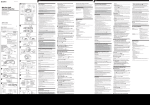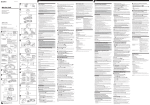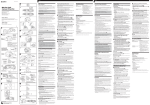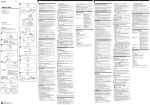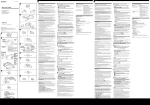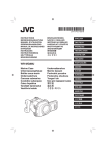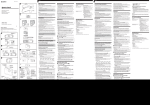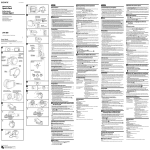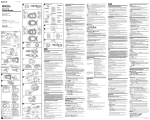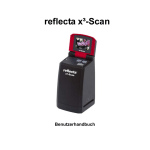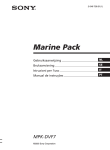Download MPK-WD
Transcript
3-298-363-11(1) 2- Waterproof Case MENU button Touche MENU Marine pack Enter button Touche (Entrée) (Flash) button Touche (Flash) Caisson étanche (Playback) button Touche (Lecture) Operating Instructions Mode d’emploi Manual de instrucciones Gebruiksaanwijzing Owner’s Record The model and serial numbers are located inside of the unit. Record the serial number in the space provided below. Refer to them whenever you call upon your Sony dealer regarding this product. Model No. MPK-WD Attach the spacer supplied with the marine pack to prevent wear of the O-ring. (See illustration ) Prevent dust from collecting on the O-ring. Lightly coat the O-ring with grease and insert it into the seating groove, then store the marine pack in a cool, well-ventilated location. Do not fasten the buckle. Avoid storing the marine pack in a cold, very hot or humid place, or together with naphthalene or camphor, as these conditions might damage the marine pack. HOME button Touche HOME (Macro) button Touche (Macro) Boîtier étanche When storing the marine pack DISP button Touche DISP (Self-timer) button Touche (Retardateur) (Slideshow) button Touche (Diaporama) 2 Serial No. _________________________ 1 Open the marine pack. (-1) 3 © 2008 Sony Corporation Printed in Japan 1 Hook for hand strap Crochet pour courroie de mein 2 4 Front protector Protection avant English Main Feature Filetage pour trépied Utilisez un trépied dont la vis mesure 5,5 mm de long ou moins. Cet équipement ne peut pas se fixer solidement sur un trépied à vis longue. Celle-ci pourrait aussi l’endommager. Useable at a depth of up to 40 m (132 feet) underwater. This marine pack MPK-WD is exclusively for use with the Sony Digital Still Camera DSC-W300/W170/W150. (Not all Cyber-shot are available in all countries or regions.) This marine pack is waterproof so the digital still camera can be used in the rain, snow, at the beach, or underwater. Using the marine pack with the digital still camera setting to (Underwater) will enable you to record beautiful underwater images. OPEN button Touches OPEN Zoom (W/T) buttons Touches de zoom (W/T) Precautions 3 LCD hood Pare-soleil de l’écran LCD When using this marine pack while diving, be sure to pay attention to the surrounding situation. Lack of attention may cause an accident while diving. In case a water leakage is occurred, be sure to pay attention to the surrounding situation and surface following the safety rules for diving. Do not subject the front glass to strong shock, as it may crack. Avoid opening the marine pack at the beach or on the water. Preparation such as installing the digital still camera and changing the “Memory Stick Duo” should be done in a place with low humidity and no salty air. Do not throw the marine pack into the water. Avoid using the marine pack in places with strong waves. Avoid using the marine pack under the following situations: in a very hot or humid place. in water hotter than 40˚C (104˚F). at temperatures lower than 0˚C (32˚F). In these situations moisture condensation or water leakage may occur and damage the equipment. Use the marine pack for no longer than 30 minutes at a time in temperatures above 35˚C (95˚F). Do not leave the marine pack under direct sunlight in a very hot and humid place for a long period of time. If you cannot avoid leaving the marine pack under direct sunlight, be sure to cover the pack with a towel or other protection. The digital still camera heats up if it is used inside the marine pack for a long time. Before removing the digital still camera from the marine pack, leave the marine pack in the shade or other cool place for a while to cool down. Buckle Fermoir Mode dial Sélecteur Mode Operation buttons Touches d’opérations O-ring Joint torique Drip-proof packing Garniture pare-gouttes Spacer (remove to use the marine pack) Entretoise (à retirer avant d’utiliser le Marine Pack) Detaching the shutter lever Retrait de la manette du déclencheur A loose or nipped O-ring, sand or dirt on the O-ring may cause water leaks under water. Be sure to check the O-ring before use. For details, read the O-ring Maintenance Manual. Attaching the shutter lever Fixation de la manette du déclencheur If sun oil is on the marine pack, be sure to wash it off thoroughly using lukewarm water. If the marine pack is left with sun oil on its body, the surface of the marine pack may become discolored or damaged. (such as cracks on the surface.) Water leakage The shutter lever is removable. La manette du déclencheur est amovible. If water happens to leak in, stop exposing the marine pack to water immediately. If the digital still camera gets wet, take it to the nearest Sony dealer immediately. Repair costs must be borne by the customer. Anti-fogging effect Front glass of the marine pack has anti-fogging effect, however install the digital still camera in a low-humidity room or a similar environment. Drip-proof packing Garniture pare-gouttes Before use Before using the digital still camera underwater, first take the marine pack to a depth of about 1 m (3.3 feet) and check that the digital still camera is operating properly and that the marine pack is not leaking, then commence your dive. In the unlikely event that a malfunction of the marine pack causes damage due to water leakage, Sony does not guarantee against damages to the equipment contained in it (digital still camera, battery pack, etc.) and the recorded contents, nor expenses entailed in the photography. Front attachment A Fixation avant A Front attachment B Fixation avant B O-ring and Drip-proof packing Rear attachment A Fixation arrière A Rear attachment B Fixation arrière B O-ring After replacing, check that no water leaks in. Grease POWER button Commutateur d’alimentation Shutter lever (Shutter button) Manette du déclencheur (Déclencheur) Use the grease in the blue tube (supplied). Using the grease in the yellow tube or other manufacturer’s grease will damage the O-ring, and cause water leaks. O-ring, drip-proof packing and grease You can obtain the O-ring, drip-proof packing and grease at the nearest Sony dealer. O-ring (model No. 3-080-065-01) Drip-proof packing (model No. 3-080-066-01) Grease (model No. 3-071-370-01) Maintenance Zoom button Touche de zoom Mode dial Sélecteur Mode 2 After recording in a location with a sea breeze, wash the marine pack thoroughly in fresh water with the buckles fastened to remove salt and sand, then wipe with a soft dry cloth. It is recommended that you submerge the marine pack in fresh water for about 30 minutes. If it is left with salt on it, metal portions may be damaged or rust may form and cause water leakage. If sun oil is on the marine pack, be sure to wash it off thoroughly using lukewarm water. Wipe the inside of the marine pack with a soft dry cloth. Do not wash it with water. Be sure to perform the above maintenance each time you use the marine pack. Do not use any type of solvent such as alcohol, benzine or thinner for cleaning, as this might damage the surface finish of the marine pack. Removing the digital still camera Always be sure to turn off the power when installing or removing the digital still camera. The lens may be damaged if the power is on. 2 Press the top and bottom OPEN buttons together and release the buckle in the direction of the arrow to open the marine pack body. (-2) 3 Remove the digital still camera from the marine pack. When the digital still camera has been used for a long time, the digital still camera heats up. Turn off the power and leave for a while to cool down before removing the digital still camera from the marine pack. Be careful not to drop the digital still camera when removing it. 4 Cancel the (Underwater). 5 Set AF Illuminator to Auto. Notes Before opening the marine pack, rinse it with tap water or fresh water and then wipe the water off with a soft cloth. When opening it, be careful not to let any water from your body, hair or wetsuit cuffs drip onto the digital still camera. Before making a dive Preparing the O-ring and drip-proof packing Times that are suited for recording 1 Remove the O-ring. 2 Coat the O-ring with grease. Clean off any sand or dirt on the O-ring, in the seating groove, or on the marine pack’s body where it touches the O-ring. Coat the O-ring with a light, even layer of grease. 3 Attach the O-ring to the marine pack. 4 Check the drip-proof packing for any sand or dirt. Notes Preparing the digital still camera Install the digital still camera in a low-humidity room or a similar environment. Opening or closing the marine pack in hot or humid locations may result in fogging of the front glass. 1 Remove the strap from the digital still camera. 2 Insert the battery pack and “Memory Stick Duo.” Be sure to use a fully charged battery pack. Be sure that “Memory Stick Duo” has enough space to record images. 3 Press the POWER button to turn on the digital still camera, and set the LCD screen to “ON.” 4 Select REC Mode. (-4) 5 After pressing the MENU button, select 6 Set the AF Illuminator to “OFF.” Caractéristique principale The most suitable time for recording images is between 10:00 AM and 2:00 PM, when the sun is directly overhead. To record pictures in places where the sunlight does not reach well or at night, please use the underwater video light HVL-ML20M (optional). Utilisable jusqu’à une profondeur de 40 mètres (132 pieds) sous l’eau. Ce Marine Pack MPK-WD est conçu pour être utilisé exclusivement avec l’appareil photo numérique Sony DSC-W300/W170/W150. (Tous les Cyber-shot ne sont pas disponibles dans l’ensemble des pays et des régions.) Ce Marine Pack est étanche à l’eau, ce qui permet d’utiliser l’appareil photo numérique sous la pluie, la neige, à la plage ou sous l’eau. L’utilisation du caisson étanche avec l’appareil photo numérique réglé sur (Sous l’eau) vous permet de prendre de superbes photos sous-marines. Précautions Lorsque vous utilisez le caisson étanche pour la plongée, faites attention à l’environnement. Un manque d’attention peut être à l’origine d’un accident pendant la plongée. En cas d’infiltration d’eau, faites attention à l’environnement et remontez à la surface en respectant les règles de plongée. Ne soumettez pas le verre avant à des chocs importants car il pourrait se fendre. N’ouvrez pas le Marine Pack sur la plage ou dans l’eau. Les opérations préparatoires, telles que la mise en place de l’appareil photo numérique et le changement de « Memory Stick Duo », doivent être effectuées à l’abri de l’humidité et de l’air salin. Ne jetez pas le Marine Pack dans l’eau. N’utilisez pas le Marine Pack par fortes vagues. N’utilisez pas le Marine Pack dans les conditions suivantes: dans un endroit très chaud ou humide, dans de l’eau chaude à plus de 40°C (104°F), à des températures inférieures à 0°C (32°F). Dans de telles conditions, le matériel pourrait être endommagé par une condensation d’humidité ou une infiltration d’eau. N’utilisez pas le Marine Pack plus de 30 minutes d’affilée par une température supérieure à 35°C (95°F). Ne laissez pas longtemps le Marine Pack en plein soleil dans un endroit très chaud et humide. Si vous ne pouvez éviter de le laisser au soleil, recouvrez-le d’une serviette ou d’une autre protection. L’appareil photo numérique s’échauffe s’il est utilisé pendant longtemps à l’intérieur du Marine Pack. Avant d’en retirer l’appareil photo, laissez temporairement le Marine Pack à l’ombre ou dans un endroit frais pour qu’il se refroidisse. Un joint torique relâché ou pincé ou la présence de sable ou de saletés sur le joint peut entraîner des infiltrations d’eau. Vérifiez le joint torique avant d’utiliser l’équipement. Pour plus d’informations, reportez-vous au Mode d’emploi du joint torique. Troubleshooting Be sure to read the separate O-ring Maintenance Manual. Important details regarding handling of the O-ring are described in this manual. Select SCN (Scene Selection) by Mode dial. Français 1 Turn off the power. (-1) *After you remove the attachment from the marine pack and store it, it should not be straightened before you store it. It can be damaged if stored while it is deformed. (Underwater) in SCN. This disables use of the AF Illuminator. Symptom There are drops of water inside the marine pack. Cause/Corrective Actions There are scratches or cracks on the O-ring. Replace the O-ring with a new one. The O-ring is not set correctly. Place the O-ring evenly in the groove. The buckle is not fastened. Fasten the buckle until it clicks. The recording function The battery pack has run out. does not work. Charge the battery pack fully. The “Memory Stick Duo” is full. Insert another “Memory Stick Duo” or erase unneeded data from the “Memory Stick Duo.” The write-protect tab on the “Memory Stick Duo” is set to LOCK. Set the tab to the recording position or insert a new “Memory Stick Duo.” The playback image is not The digital still camera may not be set to displayed in the color you (Underwater). expected. (When recording Check that the digital still camera is set to underwater) (Underwater). The underwater white balance may not be set correctly. Check the underwater white balance setting of the digital still camera. 7 Check the lens and LCD screen for any dirt. Specifications Installing the digital still camera inside the marine pack Material Plastic (PC, ABS), glass 1 Turn off the power of the digital still camera. 2 Install the digital still camera inside the marine pack. (-2) Always be sure to turn off the power when installing or removing the digital still camera. The lens may be damaged if the power is on. Check that the digital still camera is placed correctly. 3 Close the marine pack’s body and fasten the buckle. (-3) Secure the marine pack’s body, and fasten the buckle until it clicks on the top and bottom side. Notes When closing the marine pack’s body, make sure that there is no debris, sand, hair or any other foreign matter on the O-ring or in the seating groove. Water leakage may result if any such foreign matter is caught in these places. Buckle position when closing the marine pack’s body Good example (-3) Bad example (-3) If you close the buckle as shown in -3, the buckle will be caught, making it impossible to lock the marine pack. Attaching the accessories Attaching the hand strap We recommend attaching the hand strap (supplied) before using the marine pack. (See illustration ) Attaching the diffuser We recommend attaching the diffuser when you record using flash. Align the diffuser with the front protector and press it firmly as illustrated. Attaching and detaching the LCD hood How to attach (-) 1 Attach the supplied strap of the LCD hood to the marine pack. 2 Align the LCD hood with the attachment guide and press it firmly as illustrated. How to detach (-) Spread the LCD hood and detach it from the guide. Notes Be careful not to pinch the hand strap or the accessory strap when you close the marine pack body. A water leak may develop if they are caught in the body. Using the Marine Pack Recording 1 Turn on the power. (-1) 2 Press the shutter lever/shutter button to record images. (-2) Notes If you use the flash when the marine pack is attached, the shooting distance may shorten depending on the situation. It is recommended to use the underwater video light HVL-ML20M (optional). Selecting the mode Drip-proof packing Replace the drip-proof packing with a new one if you find scratches or cracks on it. -3 To previous image -3 To next image For details, refer to the operating instructions supplied with the digital still camera. Before recording images underwater, first take the marine pack to a depth of about 1 m (3.3 feet) and check that it operates properly and that there are no leaks, then commence your dive. Install the digital still camera in the marine pack before diving, and avoid opening and closing the marine pack while on board boats or at the seashore as much as possible. When installing the digital still camera, do it in a place that has as low a humidity as possible. Before using the marine pack, make sure that no debris has been caught between the front and back halves of the marine pack’s body. Before using the marine pack, always check the number of recordable images and remaining battery life. Drip-proof packing O-ring The serviceable life of the O-ring varies with frequency of use of the marine pack and conditions. Generally, it is about one year. 1 Detach the DSC-W300 front attachment A and rear attachment A (-2) Grasp the front attachment A by the parts marked in the illustration and lift it straight out. Press lightly with your finger inside wall of the rear attachment A and lift it straight out. Attach the DSC-W170/W150 front attachment B and rear attachment B (-2) Firmly press the points marked in the illustration. After replacing the attachment, press the marine pack buttons several times to check their operation. Using/Setting various functions Do not remove or apply grease to the drip-proof packing. If the packing rises up or is nipped, this may result in water leaks. If the drip-proof packing comes off, refit it carefully so that it is not twisted. (See illustration ) HOME button Touche Home Take care not to lose the spacer as you will need it to store the marine pack. This equipment uses an O-ring to maintain its water resistance. For details, refer to the separate O-ring Maintenance Manual. Improper handling of the O-ring can result in water leakage. O-ring and drip-proof packing serviceable life 1 Notes Do not remove or apply grease to the drip-proof packing. The marine pack’s body may be scratched or water may leak if the cover is closed with sand or dirt on the O-ring or drip-proof packing. 2 Tripod receptacle When using a tripod, use a tripod with 5.5 mm or shorter screws. This equipment cannot be firmly fastened on a tripod with long screws. Doing so might damage this equipment. Press the top and bottom OPEN buttons together and release the buckle in the direction of the arrow to open the marine pack body. 2 Replace the attachments. POWER button Commutateur d’alimentation Diffuser Diffuseur Front glass Verre avant Replacing the attachment MPK-WD Shutter lever (Shutter button) Manette du déclencheur (Déclencheur) The following procedures are explained using DSC-W170/W150. For details, refer to the operating instructions of your digital still camera. * If you are using the DSC-W300, the following steps are not required because the attachment A for the DSC-W300 is already attached to the marine pack at purchase. 1 Preparation 3 Select the desired image. (-3) You can use the various functions of the digital still camera installed in the marine pack. Select the REC Mode using the Mode dial on the marine pack. To record still images all REC Mode except for (Movie Mode) To record movies (Movie Mode) * While you are recording movies, audio cannot be recorded correctly. * (Underwater) is not available with movie images. (Macro) button or You can select mode in Scene Selection using the (Flash) button on the marine pack. (Twilight), (Beach), (Snow), (Fireworks), (Underwater) *When you are recording underwater images, it is recommended that you use the (Underwater). Water-resistance O-ring, buckle Pressure-resistance To a depth of up to 40 m (132 feet) underwater Switches that can be externally operated POWER (Power), Shutter, Zoom (W/T), MODE, Flash, Macro, Self-timer, DISP, Enter, MENU, HOME, Playback, Slideshow Dimensions Approx. 148 × 112 × 89 mm (5 7/8 × 4 1/2 × 3 5/8 in.) (w/h/d) (excluding the projecting parts) Mass Approx. 480 g (1 lb 1 oz.) (marine pack only) Included items Waterproof case (1) Hand strap (1) LCD hood (1) Diffuser (1) Front attachment A (for DSC-W300) (1)* Rear attachment A (for DSC-W300) (1)* *Attached to the waterproof case at purchase. Front attachment B (for DSC-W170/W150) (1) Rear attachment B (for DSC-W170/W150) (1) Grease (1) O-ring (1) Spacer (1) Set of printed documentation Optional accessories Arm kit VCT-MP1K Underwater video light HVL-ML20M (must be used together with arm kit VCT‑MP1K and “InfoLITHIUM” (M series) battery pack, (M series battery charger)) O-ring kit ACC-MP105 This marine pack allows the attachment of the products mentioned above as well as SEA&SEA SUNPAK CO., Ltd. underwater accessories. For details of those accessories, refer to the following website. http://www.seaandsea.co.jp/products/accessory/mpk/index.html Design and specifications are subject to change without notice. S’il y a de la crème solaire sur le Marine Pack, prenez soin de l’éliminer convenablement avec de l’eau tiède. Si la surface du boîtier du Marine Pack est souillée avec de la crème solaire, elle risque d’en être décolorée et endommagée. (craquelures sur la surface) Infiltration d’eau Si de l’eau s’infiltre dans le Marine Pack, arrêtez immédiatement de l’exposer à l’eau. Si l’appareil photo numérique est mouillé, portez-le immédiatement chez le revendeur Sony le plus proche. Les frais de réparation seront à la charge de l’utilisateur. Effet antigel (Flash) Adjusts for use of flash underwater. When you are recording images with a flash and not using underwater white balance is automatically set to (Auto). (Flash), the Using the zoom (See illustration ) Press on the W side for wide-angle. (Subject appears farther away.) Press on the T side for telephoto. (Subject appears closer.) Notes If you do not record any images for a certain time, the digital still camera turns off automatically to prevent the battery pack from running out. To use the digital still camera again, turn on the power again. For details, refer to the operating instructions supplied with the digital still camera. Playing back You can play back images on the LCD screen using the operation button. You cannot hear the sound. 1 Turn on the power. (-1) 2 Press the (Playback) button. (-2) 3 Fixez le joint torique sur le Marine Pack. 4 Vérifiez que la garniture pare-gouttes est exempte de sable ou de saletés. Remarques N’éliminez pas et n’appliquez pas de graisse sur la garniture pare-gouttes. Le boîtier du Marine Pack risque d’être éraflé et de l’eau pourrait s’infiltrer si le couvercle est refermé alors que du sable ou des saletés se trouvent sur le joint torique ou la garniture pare-gouttes. Veillez à lire le manuel d’entretien du joint torique fourni séparément car il renferme des informations importantes sur la manipulation du joint torique. Préparation de l’appareil photo numérique Installez l’appareil photo numérique autant que possible dans un endroit peu humide. En effet, l’ouverture ou la fermeture du Marine Pack dans un endroit chaud ou humide peut provoquer la formation de buée sur le verre avant. 1 Retirez la sangle de l’appareil photo numérique. 2 Insérez la batterie et le « Memory Stick Duo ». Veillez à utiliser une batterie complètement chargée. Vérifiez que le « Memory Stick Duo » dispose de suffisamment d’espace pour enregistrer des images. 3 Appuyez sur la touche POWER pour mettre l’appareil photo numérique sous tension et réglez l’écran LCD sur « ON ». 4 Sélectionnez Mode ENR. (-4) Sélectionnez SCN (Sélection scène) à l’aide du sélecteur de mode. 5 Après l’appui de la touche MENU, sélectionnez mode SCN. 6 Réglez Illuminat. AF sur « OFF ». (Sous l’eau) en Cela désactive l’utilisation de l’Illuminat. AF. 7 Vérifiez que l’objectif et l’écran LCD ne sont pas sales. Mise en place de l’appareil photo numérique dans le Marine Pack 1 Mettez l’appareil photo numérique hors tension. 2 Installez l’appareil photo numérique dans le Marine Pack. (-2) N’oubliez pas de mettre l’appareil photo hors tension lorsque vous l’installez ou retirer. L’objectif peut être endommagé si vous laissez l’appareil photo sous tension. Joint torique et garniture pare-gouttes Joint torique L’équipement utilise un joint torique pour garantir son étanchéité. Pour plus d’informations, reportez-vous au Mode d’emploi séparé du joint torique. Une manipulation inadéquate du joint torique peut entraîner une infiltration d’eau. Garniture pare-gouttes Ne retirez pas et ne placez pas de graisse sur la garniture pare-gouttes car ceci pourrait entraîner une saillie de la garniture hors du boîtier ou son pincement. Si la garniture pare-gouttes se détache, remettez-la soigneusement en place de sorte qu’elle ne soit pas tordue. (Voir l’illustration ) Durée de service du joint torique et de la garniture pare-gouttes Joint touque La durée de service du joint torique et de la garniture pare-gouttes varie selon la fréquence d’utilisation du Marine Pack et les conditions d’entreposage. Elle est généralement d’une année environ. Garniture pare-gouttes Remplacez la garniture pare-gouttes par une neuve si elle présente des éraflures ou des craquelures. Après le remplacement, assurez-vous qu’il n’y a pas d’infiltration d’eau. Graisse Utilisez la graisse du tube bleu (fourni). L’emploi de la graisse du tube jaune ou d’une graisse d’un autre fabricant endommagerait le joint torique et entraînerait des infiltrations d’eau. Joint torique, une garniture pare-gouttes et graisse Vous pouvez vous procurer des joints toriques, une garniture pare-gouttes et de la graisse pour objectif chez un revendeur Sony. Joint torique (No. de modèle : 3-080-065-01) Garniture pare-gouttes (No. de modèle : 3-080-066-01) Graisse (No. de modèle : 3-071-370-01) Entretien Après une prise de vues dans un endroit exposé à la brise marine, lavez le Marine Pack à l’eau douce avec les fermoirs correctement verrouillés pour en faire partir le sel et le sable, puis essuyez-le avec un chiffon doux et sec. Il est recommandé de plonger le Marine Pack dans de l’eau douce pendant 30 minutes environ. Ne laissez pas de sel dessus car il pourrait attaquer les parties métalliques et de la rouille risquerait de se former et de causer une infiltration d’eau. S’il y a de la crème solaire sur le Marine Pack, prenez soin de l’éliminer convenablement avec de l’eau tiède. Essuyez l’intérieur du Marine Pack avec un chiffon doux et sec. Ne le rincez pas à l’eau. Effectuez les opérations d’entretien ci-dessus après chaque utilisation du Marine Pack. N’utilisez aucune sorte de solvant, tel qu’alcool, benzine ou diluant pour le nettoyage car ces substances peuvent attaquer la finition du Marine Pack. Lors du stockage du Marine Pack Posez l’entretoise fournie avec le Marine Pack pour protéger le joint torique contre l’usure. (Voir l’illustration ) Empêchez l’accumulation de poussière sur le joint torique. Passez une légère couche de graisse sur le joint torique et insérez-le dans la gorge du boîtier. Rangez ensuite le Marine Pack dans un endroit frais et bien aéré. Ne verrouillez pas le fermoir. Ne rangez pas le Marine Pack dans un endroit froid, très chaud ou humide ou avec de la naphtaline ou du camphre. Ceci pourrait l’endommager. Préparation Lorsque vous fermez le boîtier du Marine Pack, assurez-vous qu’il n’y a pas de saletés, de sable, de cheveux ou d’autres corps étrangers sur le joint torique ou dans la rainure du joint. Des infiltrations d’eau peuvent être occasionnées si l’un de ces corps étrangers est coincé lors de la fermeture. Position du fermoir lorsque vous fermez le boîtier du Marine Pack Fixation de la sangle Il est recommandé de fixer la sangle (fournie) avant d’utiliser le Marine Pack. (Voir illustration ) Fixation du diffuseur Il est recommandé de fixer le diffuseur lors de l’enregistrement à l’aide du flash. Alignez le diffuseur sur le protecteur avant et appuyez fermement sur celui-ci de la manière illustrée. Fixation et retrait du pare-soleil de l’écran LCD Fixation (-) 1 Fixez la sangle fournie du pare-soleil de l’écran LCD au Marine Pack. 2 Alignez le pare-soleil de l’écran LCD sur le rail de fixation et appuyez fermement dessus comme illustré. Retrait (-) Déployez le pare-soleil de l’écran LCD et détachez-le du rail. Remarques Veillez à ne pas coincer la drogonne ou la sangle de l’accessoire quand vous fermez le coffret du Marine Pack. Sinon, une fuite d’eau peut survenir. Enregistrement 1 Mettez l’appareil sous tension. (-1) 2 Appuyez sur la manette du déclencheur/déclencheur. (-2) Remarques Si vous utilisez le flash alors que le Marine Pack est fixé, la distance de prise de vue peut être réduite selon la situation. Il est recommandé d’utiliser la lampe vidéo sousmarine HVL-ML20M (en option). Utilisation/définition de différentes fonctions Vous pouvez utiliser les différentes fonctions de l’appareil photo numérique installé dans le Marine Pack. Sélection du mode Sélectionnez le Mode ENR à l’aide du sélecteur de mode du Marine Pack. Pour enregistrer des n’importe quel Mode ENR, à l’exception du images fixes mode (Mode Film) Pour enregistrer des films (Mode Film) * Pendant l’enregistrement de films, le son n’est pas correctement enregistré. * (Sous l’eau) n’est pas disponibles avec les films. Vous pouvez sélectionner le mode dans Sélection scène à l’aide de la touche (Macro) ou de la touche (Flash) du Marine Pack. (Crépuscule), (Plage), (Neige), (Feux d’artifice), (Sous l’eau) *Pour prendre des vues sous-marines, nous vous recommandons d’utiliser le réglage (Sous l’eau). Sélection de la balance des blancs sous l’eau Ajustez la tonalité des couleurs en mode (Auto) (Sous l’eau 1) (Sous l’eau 2) (Flash) (Sous l’eau). L’appareil photo règle automatiquement la tonalité des couleurs sous l’eau pour leur conférer un aspect naturel. Utilisez ce réglage pour les prises de vues sous-marines lorsque le bleu est dominant. Utilisez ce réglage pour les prises de vues sous-marines lorsque le vert est dominant. Sélectionnez ce réglage pour utiliser le flash sous l’eau. Lorsque vous prenez des vues au flash sans activer le mode blanc sous l’eau est automatiquement réglé sur (Auto). Veillez à ne pas perdre l’entretoise, car vous en aurez besoin pour ranger le Marine Pack. 2 Remettez les fixations en place. Détachez la fixation avant A et la fixation arrière A du DSC-W300 (-2) Saisissez la fixation avant A par les parties identifiées par le symbole dans l’illustration et soulevez-la pour l’extraire. Appuyez légèrement avec le doigt sur la paroi intérieure de la fixation arrière A et soulevez-la pour l’extraire. Installez la fixation avant B et la fixation arrière B du DSC-W170/W150 (-2) Appuyez fermement sur les points identifiés par le symbole dans l’illustration. Après avoir remis en place la fixation, appuyez plusieurs fois sur les touches du Marine Pack afin de vérifier leur bon fonctionnement. *Une fois la fixation retirée du Marine Pack, ne la tendez pas avant de la ranger. Si vous la rangez alors qu’elle est déformée, vous risquez de l’endommager. (Flash), Balance Utilisation du zoom (Voir l’illustration ) Appuyez sur le côté W pour des prises de vue grand angle (le sujet semble plus éloigné). Appuyez sur le côté T pour des prises de vue en mode téléobjectif (le sujet semble plus proche). Remarques Si vous n’utilisez pas l’appareil photo numérique pendant un certain temps lors d’une prise de vues, il s’éteint automatiquement pour économiser la batterie. Pour utiliser de nouveau l’appareil photo numérique, remettez-le sous tension, voir le mode d’emploi fourni avec l’appareil photo numérique. 1 Mettez l’appareil sous tension. (-1) 2 Appuyez sur la touche (Lecture). (-2) 3 Sélectionnez l’image souhaitée. (-3) Remarques En cas de problème Symptôme Cause/Remèdes Présence de gouttes d’eau à Le joint torique est entaillé ou fendillé. l’intérieur du Marine Pack. Remplacez le joint torique par un neuf. Le joint torique n’est pas correctement en place. Placez le joint torique uniformément dans la gorge. Les fermoirs sont mal verrouillés. Verrouillez correctement les fermoirs. Les fonctions La batterie est déchargée. d’enregistrement et de Rechargez complètement la batterie. lecture n’ agissent pas. Le « Memory Stick Duo » est plein. Insérez un autre « Memory Stick Duo » ou effacez les données inutiles du « Memory Stick Duo ». Le taquet de protection en écriture du « Memory Stick Duo » est réglé sur LOCK. Réglez le taquet sur la position d’enregistrement ou insérez un « Memory Stick Duo » neuf. L’image de lecture ne L’appareil photo numérique n’est peut-être pas réglé s’affiche pas dans la couleur sur (Sous l’eau). prévue. (pendant la prise Assurez-vous que l’appareil photo est réglé sur de vue sous l’eau) (Sous l’eau). La balance des blancs sous l’eau n’est peut-être pas réglée correctement. Vérifiez le réglage de la balance des blancs sous l’eau de l’appareil photo numérique. Spécifications Matière Plastique (PC, ABS), verre Vous pouvez lire des images sur l’écran LCD à l’aide de la touche de commande correspondante. Vous ne pouvez pas entendre le son. -3 Vers l’image précédente -3 Vers l’image suivante Pour plus d’informations, consultez le mode d’emploi de l’appareil photo numérique. Retrait de l’appareil photo numérique 1 Mettez l’appareil photo hors tension. (-1) N’oubliez pas de mettre l’appareil photo hors tension lorsque vous l’installez ou retirer. L’objectif peut être endommagé si vous laissez l’appareil photo sous tension. 2 Appuyez en même temps sur les touches OPEN supérieure et inférieure pour libérer le fermoir dans le sens de la flèche et ouvrir le coffret du Marine Pack. (-2) 3 Retirez l’appareil photo numérique hors du Marine Pack. Lorsque l’appareil photo numérique a fonctionné pendant longtemps, il est relativement chaud. Mettez l’appareil photo hors tension et laissez-le se refroidir pendant un certain temps avant de le retirer du Marine Pack. Veillez à ne pas faire tomber l’appareil en le retirant. 4 Annulez le mode (Sous l’eau). 5 Réglez Illuminat. AF sur Auto. Remarques Commutateurs pouvant être commandés de l’extérieur POWER (Alimentation), Déclench, Zoom (W/T), Mode, Flash, Macro, Retardateur, DISP, Entrée, MENU, HOME, Lecture, Diaporama Dimensions environ 148 × 112× 89 mm (5 7/8 × 4 1/2 × 3 5/8 po.) (l/h/p) (parties saillantes non comprises) Poids environ 480 g (1 lb 1 oz) (Marine Pack seulement) Articles inclus Boîtier étanche (1) Courroie de mein (1) Pare-soleil de l’écran LCD (1) Diffuseur (1) Fixation avant A (pour le DSC-W300) (1)* Fixation arrière A (pour le DSC-W300) (1)* *Fixée au boîtier étanche au moment de l’achat. Fixation avant B (pour le DSC-W170/W150) (1) Fixation arrière B (pour le DSC-W170/W150) (1) Graisse (1) Joint torique (1) Entretoise (1) Jeu de documents imprimés Accessoires en option Kit de bras VCT-MP1K Torche de plongée HVL-ML20M (doit être utilisée avec le kit de bras VCT‑MP1K et la batterie « InfoLITHIUM » (série M), (le chargeur de batterie série M)) Kit de joints toriques ACC-MP105 Ce Marine Pack permet la fixation des produits mentionnés ci-dessus, ainsi que des accessoires sous-marins de SEA&SEA SUNPAK CO., Ltd. Pour plus d’informations sur ces accessoires, reportez-vous au site Web suivant. http://www.seaandsea.co.jp/products/accessory/mpk/index.html La conception et les spécifications peuvent être modifiées sans préavis. Utilisation du Marine Pack Remise en place de la fixation Le meilleur moment de la journée pour la prise de vues est entre 10 h et 14 h, lorsque le soleil est à la verticale. Pour photographier dans des endroits mal éclairés par le soleil ou la nuit, utilisez la torche de plongée sous-marine HVL-ML20M (en option). Résistance à la pression Jusqu’à une profondeur de 40 m (132 pieds) sous l’eau Lecture Appuyez en même temps sur les touches OPEN supérieure et inférieure pour libérer le fermoir dans le sens de la flèche et ouvrir le coffret du Marine Pack. Meilleur moment de la journée pour la prise de vues Tenez bien le boîtier du Marine Pack et bouclez le fermoir jusqu’à ce qu’il s’encliquette sur le haut et le dessous. Remarques Les procédures qui suivent sont basées sur l’utilisation du DSC-W170/W150. Pour de plus amples informations, reportez-vous au mode d’emploi de votre appareil photo numérique. 1 Ouvrez le Marine Pack. (-1) Avant de partir faire de la photographie sous-marine, immergez le Marine Pack à 1 mètre (3,3 pieds) sous l’eau environ et assurez-vous qu’il fonctionne correctement et que de l’eau ne s’infiltre pas à l’intérieur. Installez l’appareil photo numérique dans le Marine Pack avant la plongée et, autant que possible, évitez de l’ouvrir et de le fermer à bord d’un bateau ou sur la plage. Installez l’appareil dans le Marine Pack dans un endroit aussi peu humide que possible. Avant d’utiliser le Marine Pack, assurez-vous qu’il n’y a pas de saletés coincées entre les moitiés avant et arrière du boîtier. Avant d’utiliser le Marine Pack, vérifiez toujours le nombre d’images que vous pouvez enregistrer et l’autonomie restante de la batterie. Étanchéité à l’eau Joint torique, fermoir Avant la première utilisation Avant de plonger pour une prise de vues sous-marine, immergez le Marine Pack à 1 mètre (3,3 pieds) sous l’eau environ et assurez-vous que l’eau ne s’infiltre pas à l’intérieur et que l’appareil photo numérique fonctionne correctement. Dans le cas très improbable où une anomalie du Marine Pack causerait des dommages dus à une infiltration d’eau, notez que la garantie Sony ne couvre pas les dommages subis par le matériel (appareil photo numérique, batterie, etc.) à l’intérieur du Marine Pack, le contenu enregistré ou les frais encourus pour la prise de vues. Avant de partir en plongée Assurez-vous que l’appareil photo numérique est correctement installé. 3 Fermez le boîtier du Marine Pack et bouclez le fermoir. (-3) Fixation des accessoires * Si vous utilisez le DSC-W300, vous pouvez ignorer les étapes suivantes, car la fixation A du DSC-W300 est déjà fixée au Marine Pack au moment de l’achat. The camera automatically adjusts color tones underwater so they appear natural. (Underwater 1) Adjusts for underwater conditions where blue is strong. (Underwater 2) Adjusts for underwater conditions where green is strong. Enlevez le sable et autres saletés présents sur le joint torique, sur la rainure du joint ou sur la surface du Marine Pack entrant en contact avec le joint torique. Enduisez le joint torique d’une fine couche uniforme de graisse. Bon exemple (-3) Mauvais exemple (-3) Si vous bouclez le fermoir comme illustré en -3, il sera coincé, ce qui rendra la fermeture du Marine Pack impossible. (Underwater). (Auto) 1 Retirez le joint torique. 2 Enduisez le joint torique de graisse. Le verre avant du Marine Pack a un effet antibuée mais il est préférable de préparer l’appareil photo numérique dans une pièce peu humide ou un environnement similaire. Selecting the underwater white balance Adjusts the color tone during Préparation du joint torique et de la garniture paregouttes Avant d’ouvrir le Marine Pack, rincez-le avec de l’eau du robinet ou de l’eau douce, puis essuyezle complètement avec un chiffon doux. Lorsque vous l’ouvrez, veillez à ne pas le mouiller avec l’eau de votre combinaison de plongée, de vos cheveux ou de votre corps. Cristal frontal Glas aan voorkant Gancho para la correa de muñeca Bevestigingsoog voor polsband 1 4 Botón POWER Aan/uit-schakelaar (POWER) Difusor Diffuser Palanca de obturación (disparador) Sluiterschakelaar (Sluitertoets) Protector frontal Voorglas-beschermring 2 2 Reemplazo del acoplamiento Reproducción * Si utiliza la DSC-W300, no es necesario realizar las acciones siguientes, dado que el acoplamiento A de la DSC-W300 ya está incorporado al portacámara subacuático de serie. 1 Abra el portacámara subacuático. (-1) Pulse los botones OPEN superior e inferior a la vez y suelte la hebilla en la dirección de la flecha para abrir el portacámara subacuático. Notas Vigile que el espaciador no se caiga, ya que lo necesitará para guardar el portacámara subacuático. 2 Reemplace los acoplamientos. Rosca para montaje en trípode Cuando utilice un trípode, cerciórese de que tenga un tornillo de 5,5 mm o menos. Este equipo no podrá sujetarse firmemente con tornillos largos. Además, estos tornillos podrían dañar el equipo. Español Statiefschroefgang Voor opstelling op een statief dient u een statief met een schroef die niet langer is dan 5,5 mm te gebruiken. Dit apparaat is niet stevig te bevestigen op een statief met een langere schroef. Bovendien zou een langere schroef dit apparaat kunnen beschadigen. Característica principal 3 Utilizable bajo agua a una profundidad de hasta 40 metros. Este portacámara subacuático MPK-WD está pensado para su uso exclusivo con la cámara digital de imágenes fijas Sony DSC-W300/W170/W150. (No todos los modelos Cyber-shot están disponibles en todos los países o regiones.) Este portacámara subacuático es resistente al agua, y permite utilizar la cámara digital en la lluvia, la nieve, la playa o debajo del agua. Si utiliza el portacámara subacuático con la cámara digital ajustada en (Submarino) podrá captar impresionantes imágenes submarinas. Botón de apertura (OPEN) OPEN toets Botones de zoom (W/T) Zoomtoetsen (W/T) Precauciones Cubierta de la pantalla de cristal líquido LCD-kap Cuando utilice este portacámara subacuático cuando bucee, preste atención a la situación de los alrededores. La falta de atención podría provocar un accidente durante el buceo. En caso de producirse infiltración de agua, preste atención a la situación de los alrededores y emerja de acuerdo con las normas de seguridad para buceo. No someta el cristal frontal a golpes fuertes porque podrá agrietarse. Evite abrir el portacámara subacuático en la playa o en el agua. Las operaciones de preparación como la instalación de la cámara digital de imágenes fijas y el cambio del “Memory Stick Duo” debe llevarse a cabo en lugares con poca humedad y sin aire salado. No arroje el portacámara subacuático al agua. Evite utilizar el portacámara subacuático en lugares de fuertes olas. Evite utilizar el portacámara subacuático en las situaciones siguientes: en un lugar muy cálido o húmedo. en agua más caliente de 40°C. a temperaturas inferiores a 0°C. En estas situaciones podrá producirse condensación de humedad o fugas de agua y dañarse el equipo. No utilice el portacámara subacuático durante más de 30 minutos por vez en temperaturas superiores a los 35°C. No deje el portacámara subacuático bajo la luz solar directa en un lugar muy cálido y húmedo durante largo tiempo. Si no puede evitar dejarlo bajo la luz solar directa, asegúrese de cubrirlo con una toalla u otra protección. La cámara digital se calentará si se utiliza dentro del portacámara subacuático durante mucho tiempo. Antes de extraer la cámara digital del portacámara subacuático, deje éste a la sombra o en otro lugar fresco durante cierto tiempo para que se enfríe. Hebilla Sluitklem Selector de modo Functiekeuzeknop Botones de control Bedieningstoetsen Junta tórica O-ring Empaquetadura impermeable Druppelbestendige pakking Extracción de la palanca de obturación De sluiterschakelaar verwijderen Espaciador (quítelo para usar el portacámara subacuático) Afstandsstuk (verwijderen voor gebruik van onderwaterbehuizing) Colocación de la palanca de obturación De sluiterschakelaar bevestigen Una junta tórica floja, pillada, con arena o sucia puede causar la infiltración de agua. Compruebe la junta tórica antes de utilizarla. Con respecto a los detalles, lea el manual de mantenimiento de la junta tórica. Si hay aceite bronceador en el portacámara subacuático, lávelo completamente utilizando agua tibia. Si dejase el portacámara subacuático con aceite bronceador en su cuerpo, la superficie del mismo podría decolorar o dañarse. (como rajas en la superficie.) La palanca de obturación es extraíble. De sluiterschakelaar kan worden verwijderd. Infiltración de agua En caso producirse una infiltración de agua al interior, deje de exponer el portacámara subacuático al agua inmediatamente. Si se moja la cámara digital, llévela inmediatamente al distribuidor Sony más cercano. Los costes de reparación tendrá que abonarlos el usuario. Efecto antiempañante Empaquetadura impermeable Druppelbestendige pakking El cristal frontal del portacámara subacuático tiene un tratamiento contra el empañamiento, pero tendrá que instalar la cámara en una sala con bajo nivel de humedad o en un entorno similar. Antes de la utilización Acoplamiento frontal A Hulpstuk aan de voorkant A Acoplamiento frontal B Hulpstuk aan de voorkant B Acoplamiento posterior A Hulpstuk aan de achterkant A Acoplamiento posterior B Hulpstuk aan de achterkant B Antes de utilizar la cámara digital bajo el agua, sumerja primero el portacámara subacuático a una profundidad de aproximadamente 1 metro y compruebe que la cámara digital funciona debidamente y que el portacámara subacuático no tiene fugas, y a continuación comience su buceo. En el caso improbable de que un mal funcionamiento del portacámara subacuático ocasione daños debidos a una fuga de agua, Sony no se responsabilizará de los daños al equipo alojado en él (cámara digital, batería, etc.) ni del contenido grabado, ni tampoco de los gastos relacionados con la fotografía. Junta tórica y empaquetadura impermeable Junta tórica Botón POWER Aan/uit-schakelaar (POWER) Palanca de obturación (disparador) Sluiterschakelaar (Sluitertoets) 1 Botón HOME/ HOME-toets Botón de zoom Zoomtoets 2 Empaquetadura impermeable Reemplace la empaquetadura impermeable por otra nueva cuando encuentre rayas o rajas en ella. Después del reemplazo, compruebe que no haya infiltración de agua. Grasa Botón DISP DISP-toets Botón MENU MENU toets Utilice la grasa del tubo azul (suministrado). La utilización de la grasa del tubo amarillo o de otros fabricantes podría dañar la junta tórica y causar la infiltración de agua. Botón HOME/ HOME-toets Junta tórica, empaquetadura impermeable, y grasa Botón (Intro) (Enter)-toets Botón (Macro) (Macro)-toets Usted podrá adquirir juntas tórica, empaquetadura impermeable, y grasa para objetivos en el proveedor Sony más cercano. Junta tórica (modelo núm. 3-080-065-01) Empaquetadura impermeable (modelo núm. 3-080-066-01) Grasa (modelo núm. 3-071-370-01) Botón (Flash) (Flitser)-toets Botón (Reproducción) (Afspelen)toets No quite ni aplique grasa a la empaquetadura contra la infiltración de gotas de agua. Si la empaquetara se levantase o pillase, podría infiltrarse agua. Si la empaquetadura impermeable se desprende, vuelva a colocarla cuidadosamente de forma que no quede retorcida. (Consulte la ilustración ) Junta tórica La duración útil de la junta tórica variará con la frecuencia de utilización del portacámara subacuático y las condiciones. En general, será de aproximadamente un año. 2- Empaquetadura impermeable Duración útil de la junta tórica y de la empaquetadura impermeable Selector de modo Functiekeuzeknop 1 Este equipo utiliza una junta tórica para mantener su resistencia al agua. Con respecto a los detalles, consulte el Manual de mantenimiento de la junta tórica separado. El manejo inadecuado de la junta tórica podría resultar en la infiltración de agua. Botón (Autodispar) (Zelfontspanner)-toets Botón (Diapositivas) (Diavoorstelling)toets 1 Mantenimiento Después de grabar en un lugar expuesto a brisas marinas, lave el portacámara subacuático con agua dulce para retirar la sal y la arena con las hebillas perfectamente abrochadas, y a continuación frote con un paño suave y seco. Se recomienda sumergir el portacámara subacuático en agua dulce durante unos 30 minutos. Si se deja sal en él, podrán dañarse las partes metálicas o formarse óxido y ocasionar fugas de agua. Si hay aceite bronceador en el portacámara subacuático, lávelo completamente utilizando agua tibia. Limpie el interior del portcámara subacuático con un paño suave y seco. No lo lave con agua. Cerciórese de realizar el mantenimiento indicado cada vez que lo utilice. No use ningún disolvente, como alcohol, bencina, ni diluidor de pintura para la limpieza, ya que podría dañar el acabado de la superficie del mismo. Cuando guarde el portacámara subacuático 2 3 Ponga el espaciador suministrado con el portacámara subacuático para evitar el desgaste de la junta tórica. (Consulte la ilustración ) Evite que se acumule polvo en la junta tórica. Recubra ligeramente la junta tórica con grasa e insértela en la ranura de asiento, luego guarde el portacámara subacuático en un lugar fresco y bien ventilado. No abroche la hebilla. Evite guardar el portacámara subacuático en un lugar muy cálido o húmedo, o junto con naftalina o alcanfor, ya que en estas condiciones se puede dañar el portacámara subacuático. Preparación Los siguientes procedimientos se explican mediante la utilización del modelo DSCW170/W150. Para obtener más información, consulte el manual de instrucciones de la cámara digital de imágenes fijas. Extraiga el acoplamiento frontal A y el acoplamiento posterior A de la DSC-W300 (-2) Sujete el acoplamiento frontal A por las partes marcadas en la ilustración y levántelo. Presione suavemente con el dedo la cara interna del acoplamiento posterior A y levántelo. Coloque el acoplamiento frontal B y el acoplamiento posterior B en la DSC-W170/W150 (-2) Presione con fuerza los puntos marcados como en la ilustración. Tras reemplazar el acoplamiento, presione varias veces los botones del portacámara subacuático para comprobar su funcionamiento. *Tras extraer el acoplamiento del portacámara subacuático, nunca lo alise antes de guardarlo. De lo contrario, podría dañarse por la deformación. Preparación de la junta tórica y del empaquetadura impermeable 1 Extraiga la junta tórica. 2 Engrase la junta tórica. Limpie la arena o la suciedad de la junta tórica, de la ranura de asentamiento o del cuerpo del portcámara subacuático donde toque dicha junta. Cubra la junta con una capa de grasa ligera y uniforme. 3 Inserte la junta tórica en el portcámara subacuático. 4 Compruebe que no haya arena ni suciedad en el empaquetadura impermeable. Notas No retire el embalaje impermeable ni lo engrase. Es posible que el cuerpo del portcámara subacuático se ralle o que se filtre agua si cierra la cubierta con arena o suciedad en la junta tórica o en el empaquetadura impermeable. Asegúrese de leer el Manual de mantenimiento de la junta tórica suministrado por separado. En este manual se proporciona información importante referente al manejo de dicha junta tórica. Preparación de la cámara digital de imágenes fijas Instale la cámara digital de imágenes fijas en una sala o un entorno similar con poca humedad. La apertura o el cierre del portcámara subacuático en lugares cálidos o húmedos podría provocar que el cristal frontal se empañase. 1 Quite la correa de la cámara digital de imágenes fijas. 2 Inserte la batería y el “Memory Stick Duo”. Asegúrese de utilizar una batería totalmente cargada. Asegúrese de que el “Memory Stick Duo” dispone de espacio suficiente para grabar imágenes. 3 Pulse el botón POWER para encender la cámara y ajuste la pantalla LCD en “ON”. 4 Seleccione Modo Grabación. (-4) Seleccione SCN (Selección escena) con el selector de modo. 5 Tras pulsar el botón MENU, seleccione 6 Ajuste el Iluminador AF en “OFF”. (Submarino) en SCN. Esta acción desactiva el uso del Iluminador AF. 7 Compruebe el objetivo y la pantalla LCD para detectar restos de suciedad. Instalación de la cámara digital de imágenes fijas en el portcámara subacuático 1 Desconecte la alimentación de la cámara digital de imágenes fijas. 2 Instale la cámara digital de imágenes fijas en el portcámara subacuático. (-2) Antes de instalar o extraer la cámara digital, desconecte su alimentación. Si dejase la alimentación conectada, el objetivo podría dañarse. Asegúrese de que la cámara digital de imágenes fijas está colocada correctamente. 3 Cierre el cuerpo del portcámara subacuático y apriete la hebilla. (-3) Asegure el cuerpo del portcámara subacuático y apriete la hebilla hasta oír un clic en la parte superior e inferior. Notas Al cerrar el cuerpo del portcámara subacuático, asegúrese de que no haya residuos, arena, cabellos ni ningún otro cuerpo extraño ni en la junta tórica ni en la ranura de asentamiento. Si hubiera algún cuerpo extraño en dichos lugares, podrían producirse filtraciones de agua. Posición de la hebilla al cerrar el cuerpo del portcámara subacuático Posición correcta (-3) Posición incorrecta (-3) Si cierra la hebilla en la posición mostrada en la ilustración -3, ésta se atascará y no será posible cerrar el portcámara subacuático. Instalación de los accesorios Colocación de la correa de mano Recomendamos colocar la correa de mano (suministrada) antes de utilizar el portacámara subacuático. (Consulte la ilustración ) Colocación del difusor Recomendamos colocar el difusor al grabar utilizando el flash. Ajuste el difusor con el protector frontal y presione con fuerza tal y como se muestra en la ilustración. Instalación y extracción de la cubierta de la pantalla de cristal líquido Instalación (-) 1 Coloque la correa de la cubierta de la pantalla de cristal líquido suministrada al portacámara subacuático. 2 Ajuste la cubierta con la guía de acoplamiento y presione con fuerza tal y como se muestra en la ilustración. Extracción (-) Separe la cubierta de la pantalla de cristal líquido de la guía. Notas Tenga cuidado de no pillar la correa de mano o la correa de muñeca al cerrar el cuerpo del portacámara subacuático. Si quedan atrapadas en el cuerpo podría producirse una fuga de agua. Utilización del portacámara subacuático Grabación Notas Si utiliza el flash cuando el portacámara subacuático esté conectado, la distancia de fotografiado puede acortarse dependiendo de la situación. Se recomienda utilizar la lámpara para vídeo subacuática HVL-ML20M (opcional). Uso/ajuste de diferentes funciones Puede utilizar las diferentes funciones de la cámara digital de imágenes fijas instalada en el portacámara subacuático. Selección del modo Seleccione el Modo Grabación con el selector de modo del portacámara subacuático. Para grabar imágenes fijas siempre Modo Grabación excepto en (Modo película) Para grabar películas (Modo película) * Mientras graba películas, el audio no puede grabarse correctamente. * (Submarino) no está disponible con las películas. Puede seleccionar el modo en Selección de escena con el botón (Macro) o (Flash) del portacámara subacuático. (Crepúsculo), (Playa), (Nieve), (Fuegos artificiales), (Submarino) *Al grabar imágenes subacuáticas, se recomienda utilizar la opción (Submarino). Selección del Balance Blanco submarino Ajusta el tono del color en el modo (Submarino 1) (Submarino 2) (Flash) 1 Conecte la alimentación. (-1) 2 Pulse el botón (Reproducción). (-2) 3 Seleccione la imagen deseada. (-3) -3 A la imagen anterior -3 A la imagen siguiente Para más detalles, consulte el manual de instrucciones suministrado con la cámara digital. Extracción de la cámara digital 1 Desconecte la alimentación. (-1) Antes de instalar o extraer la cámara digital, desconecte su alimentación. Si dejase la alimentación conectada, el objetivo podría dañarse. 2 Presione simultáneamente los botones OPEN superior e inferior y suelte la hebilla en el sentido de la flecha para abrir el cuerpo del portacámara subacuático. (-2) 3 Extraiga la cámara digital del portacámara subacuático. Cuando haya utilizado la cámara digital durante mucho tiempo, se calentará. Desconecte la alimentación de la cámara digital, y deje que se enfríe durante cierto tiempo antes de extraerla del portacámara subacuático. Tenga cuidado de no dejar caer la cámara digital cuando la extraiga. 4 Cancele el modo (Submarino). 5 Ajuste el Iluminador AF en Auto. Notas Antes de abrir el portacámara subacuático, aclárelo con agua del grifo o con agua dulce y luego frótelo con un paño suave y seco. Cuando lo abra, tenga cuidado de no dejar que chorree agua de su cuerpo, cabello o traje de agua en la cámara digital. Antes de bucear Antes de grabar imágenes bajo el agua, sumerja primero el portacámara subacuático a una profundidad de aproximadamente 1 metro y compruebe que funciona debidamente y que no haya fugas, y a continuación comience su buceo. Instale la cámara digital en el portacámara subacuático antes de bucear, y evite, en lo posible, abrir y cerrarlo cuando esté en una embarcación o en la costa del mar. Cuando instale la cámara digital, hágalo en un lugar donde haya la menor humedad posible. Antes de utilizar le portacámara subacuático, cerciórese de que no hayan residuos pillados entre las mitades delantera y trasera del cuerpo del portacámara subacuático. Antes de utilizar el portcámara subacuático, compruebe siempre el número de imágenes que se pueden grabar y la batería restante. Horas apropiadas para grabar (Submarino). La cámara ajusta automáticamente los tonos de color bajo el agua para que tengan un aspecto natural. Ajustes para condiciones subacuáticas con un azul muy intenso. Ajustes para condiciones subacuáticas con un verde muy intenso. Ajustes para utilizar el flash bajo el agua. Al grabar imágenes con flash sin utilizar la opción (Flash), el Balance Blanco submarino se ajusta automáticamente en (Auto). Utilización del zoom (Consulte la ilustración ) Pulse el lado W para gran angular. (El motivo aparecerá más alejado.) Pulse el lado T para telefoto. (El motivo aparecerá más cerca.) Notas Si no graba imágenes durante un cierto periodo de tiempo, la cámara digital de imágenes fijas se apagará automáticamente para evitar que se agote la batería. Para volver a utilizar la cámara digital, vuelva a conectar su alimentación. Con respecto a los detalles, consulte el manual de instrucciones suministrado con la cámara digital. Belangrijkste kenmerk Te gebruiken tot op een diepte van wel 40 meter onder water. Deze onderwaterbehuizing MPK-WD is uitsluitend bestemd voor gebruik met de digitale fotocamera DSC-W300/W170/W150 van Sony. (Niet alle Cyber-shots zijn beschikbaar in alle landen of regio’s.) Deze onderwaterbehuizing is waterbestendig, zodat u de digitale fotocamera ook kunt gebruiken bij regen, sneeuw, aan het strand of onder water. Het gebruik van deze onderwaterbehuizing met de digitale fotocamera ingesteld op (Onderwater) zal u in staat stellen om prachtige onderwateropnamen te maken. Voorzorgsmaatregelen Bij gebruik van dit onderwater-camerahuis tijdens het duiken dient u altijd goed op te letten wat er om u heen gebeurt. Onoplettendheid tijdens het duiken kan bijzonder gevaarlijk zijn. Ook als u merkt dat er water in het camerahuis binnenlekt, mag u niet uw directe omgeving uit het oog verliezen, maar dient u voorzichtig op te stijgen naar het oppervlak, volgens de regels voor veilig duiken. Stel het glas aan de voorkant niet bloot aan krachtige schokken, aangezien het hierdoor kan gaan barsten. Open de onderwaterbehuizing niet op het strand of op het water. U moet de voorbereiding, zoals het installeren van de digitale fotocamera en het vervangen van de "Memory Stick Duo", uitvoeren op een plaats met een lage luchtvochtigheid en geen zoute lucht. Gooi de onderwaterbehuizing niet in het water. Gebruik de onderwaterbehuizing niet op plaatsen met een sterke golfslag. Gebruik de onderwaterbehuizing niet onder de volgende omstandigheden: op een zeer warme of vochtige plaats in water met een temperatuur boven 40°C bij temperaturen beneden 0°C Onder bovengenoemde omstandigheden kan er condensvorming of waterlekkage optreden waardoor de apparatuur beschadigd kan raken. Bij temperaturen boven 35°C mag u de onderwaterbehuizing niet langer dan 30 minuten achtereen gebruiken. Laat de onderwaterbehuizing niet achter op een zeer warme en vochtige plaats waar deze langdurig is blootgesteld aan direct zonlicht. Indien u de onderwaterbehuizing beslist moet achterlaten op een plaats met direct zonlicht, dient u de behuizing altijd te bedekken met een handdoek of andere bescherming. De digitale fotocamera kan na langdurig gebruik in het onderwaterhuis nogal warm worden. Alvorens u de digitale fotocamera uit het onderwaterhuis verwijdert, dient u eerst het onderwaterhuis met de camera er in een tijdje in de schaduw te leggen of op een andere koele plaats, om de camera te laten afkoelen. La hora más apropiada para grabar imágenes es entre las 10:00 AM y las 2:00 PM, cuando el sol se encuentra directamente encima. Para grabar imágenes en lugares en los que no llegue bien la luz solar, o por la noche, utilice una lámpara para vídeo subacuática HVL–ML20M (opcional). Een O-ring die los zit, beschadigd of vuil is door stof of zand zou onder water lekkage kunnen veroorzaken. Controleer voor het gebruik altijd zorgvuldig de O-ring. Zie voor nadere bijzonderheden de O-ring onderhoudshandleiding. Solución de problemas Síntoma Hay gotas de agua dentro del portacámara subacuático. Causa/acciones correctivas Hay raspaduras o grietas en la junta tórica. Sustituya la junta tórica con otra nueva. La junta tórica no está puesta correctamente. Ponga la junta tórica uniformemente en la ranura. La hebilla no está abrochada. Abroche la hebilla hasta que produzca un chasquido. Las funciones de grabación La batería se ha agotado. no trabajan. Cargue completamente la batería. El “Memory Stick Duo” está lleno. Inserte otro o borre los datos innecesarios del “Memory Stick Duo”. La lengüeta de protección contra escritura del “Memory Stick Duo” está ajustada en la posición LOCK. Ajústela en la posición de grabación o inserte un nuevo “Memory Stick Duo”. La imagen reproducida Puede que la cámara digital no esté ajustada en no aparece en el color que (Submarino). esperaba. (Al grabar bajo Compruebe que la cámara digital está ajustada en el agua) (Submarino). Puede que el Balance Blanco submarino no esté ajustado correctamente. Compruebe el ajuste de Balance Blanco submarino de la cámara digital. Especificaciones Material Plástico (PC, ABS), cristal Estanqueidad Junta tórica, hebilla Resistencia a la presión Hasta una profundidad de 40 metros bajo el agua Interruptores que se pueden accionar externamente POWER (alimentación), Obtrad, Zoom (W/T), Modo, Flash, Macro, Autodisparador, DISP, Intro, MENU, HOME, Reproducción, Diapositivas Dimensiones Aprox. 148 × 112 × 89 mm (an/al/prf) (excluidas las piezas protectoras) Peso Aprox. 480 g (portacámara subacuático solamente) Elementos incluidos Funda resistente al agua (1) Correa de muñeca (1) Cubierta de la pantalla de cristal líquido (1) Difusor (1) Acoplamiento frontal A (para DSC-W300) (1)* Acoplamiento posterior A (para DSC-W300) (1)* * Se incluye con la funda resistente al agua al comprar el producto. Acoplamiento frontal B (para DSC-W170/W150) (1) Acoplamiento posterior B (para DSC-W170/W150) (1) Grasa (1) Junta tórica (1) Espaciador (1) Juego de documentación impresa Accesorios opcionales Juego de brazo VCT-MP1K Lámpara para vídeo subacuática HVL-ML20M (tendrá que utilizarse junto con el juego de brazo VCT-MP1K y la batería “InfoLITHIUM” (serie M), (cargador de baterías de la serie M)) Kit de anillo tórico ACC-MP105 Este portacámara subacuático permite instalar los productos mencionados y también accesorios submarinos de SEA&SEA SUNPAK CO., Ltd. Si desea más información sobre los accesorios, consulte el sitio web siguiente. http://www.seaandsea.co.jp/products/accessory/mpk/index.html El diseño y las especificaciones están sujetos a cambio sin previo aviso. 1 Conecte la alimentación. (-1) 2 Pulse la palanca de obturación o el disparador. (-2) (Auto) Es posible reproducir imágenes en la pantalla de cristal líquido mediante el botón de control. No podrá oír el sonido. Nederlands Als er zonnebrandolie op het onderwaterhuis is gekomen, wast u het dan grondig af met lauwwarm water. Resten zonnebrandolie op het onderwaterhuis kunnen de afwerking van het camerahuis aantasten of doen verkleuren. (en er zouden barstjes in het oppervlak kunnen ontstaan.) Waterlekkage Indien er toevallig water naar binnen is gelekt, zorg dan onmiddellijk dat de onderwaterbehuizing niet langer aan water wordt blootgesteld. Indien de digitale fotocamera nat is geworden, dient u deze onmiddellijk naar de dichtstbijzijnde Sony-handelaar te brengen. De kosten van de reparatie worden de klant in rekening gebracht. Ontwasemend effect Het voorglas van het onderwaterhuis heeft een ontwasemend effect, maar toch dient u de digitale fotocamera in het onderwaterhuis te installeren in een niet al te vochtige omgeving. Vóór gebruik Alvorens u de digitale fotocamera onder water gaat gebruiken, dient u de onderwaterbehuizing eerst tot op een diepte van circa 1 meter te brengen en te controleren of de digitale fotocamera naar behoren werkt en de onderwaterbehuizing niet lekt. Daarna kunt u beginnen met duiken. Indien er door een defect van de onderwaterbehuizing als gevolg van waterlekkage schade ontstaat, hetgeen overigens zeer onwaarschijnlijk is, aanvaardt Sony geen aansprakelijkheid voor eventuele beschadiging van de daarin aanwezige apparatuur (digitale fotocamera, batterij, enz.) en de gemaakte opnamen, en evenmin voor de kosten die verbonden zijn aan het fotograferen. O-ring en druppelbestendige pakking Bevestig het hulpstuk voor de voorkant B en het hulpstuk voor de achterkant B op de DSC-W170/W150 (-2) Druk stevig op de punten gemarkeerd met in de afbeelding. Druk meerdere keren op de toetsen van de onderwaterbehuizing om hun werking te controleren, nadat u het hulpstuk hebt vervangen. *Nadat u het hulpstuk hebt verwijderd van de onderwaterbehuizing en opbergt, mag u het niet rechtmaken voor u het opbergt. Het kan worden beschadigd als het wordt opgeborgen terwijl het vervormd is. De O-ring en druppelbestendige pakking voorbereiden 1 Verwijder de O-ring. 2 Vet de O-ring in met smeervet. Verwijder zand en vuil van de O-ring, uit de pakkinggroef en van het gedeelte van de onderwaterbehuizing waar deze de O-ring raakt. Bedek de O-ring met een dun, gelijkmatig laagje smeervet. 3 Plaats de O-ring in de onderwaterbehuizing. 4 Controleer of de druppelbestendige pakking zand of vuil bevat. Opmerkingen Verwijder de druppelbestendige pakking niet en vet deze niet in met smeervet. De onderwaterbehuizing kan worden bekrast of kan gaan lekken als de klep wordt gesloten met zand of vuil op de O-ring of druppelbestendige pakking. Lees ook de afzonderlijke O-ring onderhoudshandleiding. In dit gedeelte wordt informatie gegeven over het gebruik van de O-ring. De digitale fotocamera voorbereiden IInstalleer de digitale fotocamera in een ruimte met een lage luchtvochtigheid of een vergelijkbare omgeving. Als u de behuizing in een zeer warme of vochtige omgeving opent, kan het voorglas beslaan. 1 Verwijder de riem van de digitale fotocamera. 2 Plaats de accu en "Memory Stick Duo". Gebruik een volledig opgeladen accu. Zorg ervoor dat er voldoende ruimte vrij is op de "Memory Stick Duo" om beelden op te nemen. 3 Druk op de POWER-toets om de digitale fotocamera in te schakelen en stel het LCD-scherm in op "ON". 4 Selecteer Opn.functie. (-4) Selecteer SCN (Scènekeuze) met de functiekeuzeknop. 5 Nadat u op de MENU-toets hebt gedrukt, selecteert u (Onderwater) in SCN. 6 Stel de AF-verlicht. in op "OFF". Hierdoor wordt de AF-verlicht. uitgeschakeld. 7 Controleer of de lens en het LCD-scherm vuil zijn. Zet voor het aanbrengen of verwijderen van de digitale fotocamera die altijd eerst uit. Met de camera ingeschakeld zou de lens beschadigd kunnen worden. Controleer of de digitale fotocamera juist is geplaatst. 3 Sluit het hoofdgedeelte van de onderwaterbehuizing en maak de sluitklem vast. (-3) Als u het hoofdgedeelte van de onderwaterbehuizing sluit, moet u ervoor zorgen dat er op de O-ring of in de pakkinggroef geen vuil, zand, haren of andere deeltjes meer aanwezig zijn die daar niet thuishoren. Als dergelijk vuil en dergelijke resten achterblijven op deze plaatsen, kan er waterlekkage optreden. Positie van de sluitklem wanneer het hoofdgedeelte van de onderwaterbehuizing is gesloten De polsriem bevestigen Onderhoud Na het maken van opnamen op een plaats met harde zeewind dient u de onderwaterbehuizing – met de gespen stevig vast – met zoet water te wassen om zout en zand te verwijderen. Veeg na met een zachte droge doek. Het is aan te bevelen om de onderwaterbehuizing gedurende circa 30 minuten ondergedompeld te laten in zoet water. Indien er zout op blijft zitten, bestaat de kans dat de metalen onderdelen beschadigd raken of gaan roesten en waterlekkage veroorzaken. Als er zonnebrandolie op het onderwaterhuis is gekomen, wast u het dan grondig af met lauwwarm water. Reinig de binnenkant van de onderwaterbehuizing met een zachte, droge doek. Reinig de binnenkant niet met water. Verricht het bovenstaande onderhoud iedere keer dat u het onderwater-camerahuis gebruikt. Gebruik voor het schoonmaken geen oplosmiddelen zoals thinner, benzeen, alcohol en dergelijke, want deze middelen kunnen de afwerking van het onderwater-camerahuis aantasten. Opbergen van de onderwaterbehuizing Bevestig het met de onderwaterbehuizing meegeleverde afstandsstuk om slijtage van de O-ring te voorkomen. (Zie afb. ) Zorg dat er zich geen stof op de O-ring kan ophopen. Breng een dun laagje vet aan op de O-ring en plaats deze in de pakkinggroef. Berg de onderwaterbehuizing vervolgens op een koele, goed geventileerde plaats op. Maak de sluitklem niet vast. De onderwaterbehuizing mag niet worden opgeborgen op een koude of zeer warme of vochtige plaats, en ook niet samen met naftaleen of kamfer, aangezien de onderwaterbehuizing hierdoor beschadigd kan raken. Voorbereiding De LCD-kap bevestigen en verwijderen Bevestigen (-) Spreid de LCD-kap en maak deze los van de geleider. Opmerkingen Let op dat de polsriem of onderdelenriem niet geklemd raakt wanneer u de onderwaterbehuizing sluit. Er kan een waterlek ontstaan als deze klem komen te zitten in de behuizing. Opnemen Opmerkingen Als u de flitser gebruikt terwijl de onderwaterbehuizing bevestigd is, kan de opnameafstand kleiner worden afhankelijk van de situatie. We raden u aan om de onderwatervideolamp HVL-ML20M (optioneel) te gebruiken. Verschillende functies gebruiken/instellen U kunt de verschillende functies van de digitale fotocamera gebruiken wanneer deze in de onderwaterbehuizing is geplaatst. De functie selecteren Selecteer de Opn.functie met de functiekeuzeknop op de onderwaterbehuizing. Foto’s maken allemaal Opn.functie behalve (Bewegende beelden) Films opnemen (Bewegende beelden) * Terwijl u films opneemt, kan het geluid niet correct worden opgenomen. * (Onderwater) is niet beschikbaar voor videobeelden. U kunt de functie selecteren in Scènekeuze met de (Macro)-toets of (Flitser)-toets op de onderwaterbehuizing. (Schemer), (Strand), (Sneeuw), (Vuurwerk), (Onderwater) *Wanneer u onderwateropnamen maakt, gebruikt u best (Onderwater). De witbalans onderwater selecteren Pas de kleurtoon aan tijdens de (Onderwater). De camera past de kleurtonen onderwater automatisch aan zodat ze natuurlijk overkomen. (Onderwater 1) Past de kleurtonen aan voor onderwateromstandigheden waarbij blauw overheerst. (Onderwater 2) Past de kleurtonen aan voor onderwateromstandigheden waarbij groen overheerst. Past de kleurtonen aan om de flitser onderwater te kunnen (Flitser) gebruiken. (Autom.) Wanneer u beelden opneemt met flitser en (Flitser) niet gebruikt, wordt de witbalans onderwater automatisch ingesteld op (Autom.). De zoom gebruiken (Zie afbeelding ) Druk op de W-zijde voor groothoek. (Het onderwerp lijkt zich verder weg te bevinden.) Druk op de T-zijde voor telefoto. (Het onderwerp lijkt zich dichterbij te bevinden.) Opmerkingen Als u een bepaalde tijd geen beelden opneemt, wordt de digitale fotocamera automatisch uitgeschakeld om te voorkomen dat de batterij leegraakt. Om de digitale fotocamera weer te gebruiken, schakelt u de stroom weer in. Zie voor nadere bijzonderheden tevens de gebruiksaanwijzing van de digitale fotocamera. 1 Schakel de camera in. (-1) 2 Druk op de (Afspelen)-toets. (-2) 3 Selecteer het gewenste beeld. (-3) Opmerkingen Let op dat u het afstandsstuk niet losmaakt, omdat u dit nodig hebt om de onderwaterbehuizing op te bergen. 2 Vervang de hulpstukken. Verwijder het hulpstuk voor de voorkant A en het hulpstuk voor de achterkant A van de DSC-W300 (-2) Neem het hulpstuk voor de voorkant A vast bij de delen gemarkeerd met in de afbeelding en trek het recht naar buiten. Druk lichtjes met uw vinger op de binnenkant van het hulpstuk voor de achterkant A en trek het recht naar buiten. Probleem Er zitten druppeltjes water binnen in de onderwaterbehuizing. De opnamefunctie werkt niet. Het weergegeven beeld wordt niet weergegeven in het verwachte kleur (bij onderwateropnamen) Oorzaak en/of oplossing De O-ring is gekrast of gescheurd. Vervang de O-ring door een nieuw exemplaar. De O-ring is niet correct aangebracht. Plaats de O-ring gelijkmatig in de groef. De sluitklem zit niet stevig dicht. Druk de sluitklem dicht totdat deze vastklikt. De batterij is leeg. Laad de batterij volledig op. De "Memory Stick Duo" is vol. Plaats een andere "Memory Stick Duo" in de camera of verwijder ongewenste gegevens van de "Memory Stick Duo". Het schrijfbeveiligingsnokje op de "Memory Stick Duo" is ingesteld op LOCK. Zet het nokje in de opnamepositie of plaats een nieuwe "Memory Stick Duo". De digitale fotocamera is mogelijk niet ingesteld op (Onderwater). Ga na of de digitale fotocamera is ingesteld op (Onderwater). De witbalans onderwater is mogelijk niet correct ingesteld. Controleer de instelling voor de witbalans onderwater van de digitale fotocamera. Specificaties Materiaal Kunststof (PC, ABS), glas Drukbestendigheid Tot op een diepte van 40 m onder water Gewicht Ongeveer 480 g (alleen onderwaterbehuizing) We raden u aan om de diffuser te bevestigen wanneer u opnamen maakt met de flitser. Lijn de diffuser uit met de voorglasbeschermring en druk deze stevig vast, zoals afgebeeld. Het hulpstuk vervangen Druk tegelijk op de OPEN-toetsen bovenaan en onderaan en maak de gesp los in de richting van de pijl om de onderwaterbehuizing te openen. Verhelpen van storingen De diffuser bevestigen Afspelen 1 Open de onderwaterbehuizing. (-1) De beste tijd voor het opnemen onder water is tussen 10:00 uur ’s ochtends en 2:00 uur ’s middags, wanneer de zon hoog aan de hemel staat. Voor heldere opnamen bij nacht of op plaatsen waar geen zonlicht doordringt, kunt u gebruik maken van de HVL-ML20M onderwater-videolamp (optioneel). Afmetingen Ongeveer 148 × 112 × 89 mm (b/h/d) (exclusief uitstekende delen) De volgende procedures worden uitgelegd voor DSC-W170/W150. Raadpleeg de gebruiksaanwijzing van uw digitale fotocamera voor meer details. * Als u de DSC-W300 gebruikt, zijn de volgende stappen niet nodig omdat het hulpstuk A voor de DSC-W300 al is bevestigd op de onderwaterbehuizing bij aankoop. Geschikte tijden voor opnemen We raden u aan om de polsriem (bijgeleverd) te bevestigen voordat u de onderwaterbehuizing gebruikt. (Zie afbeelding ) 1 Schakel de camera in. (-1) 2 Druk op de sluiterschakelaar/sluitertoets. (-2) Reserve O-ringen, druppelbestendige pakkingen en smeervet zijn verkrijgbaar bij de dichtstbijzijnde Sony leverancier. O-ring (bestelnummer 3-080-065-01) Druppelbestendige pakking (bestelnummer 3-080-066-01) Smeervet (bestelnummer 3-071-370-01) Alvorens u beelden onder water gaat opnemen, dient u de onderwaterbehuizing eerst tot op een diepte van circa 1 meter te brengen en te controleren of deze niet lekt. Daarna kunt u beginnen met duiken. Installeer de digitale fotocamera geruime tijd voor het duiken in het onderwatercamerahuis en zorg dat het onderwaterhuis op zee of aan de waterkant zo min mogelijk geopend wordt. Kies voor het aanbrengen van de digitale fotocamera in het onderwater-camerahuis een plaats met zo weinig mogelijk vocht. Controleer voor elk gebruik van het onderwater-camerahuis nog even of er niets, ook geen haartje, klem is geraakt tussen de voorste en de achterste helft van het onderwaterhuis. Voordat u de onderwaterbehuizing gebruikt, moet u altijd het aantal opneembare beelden en de resterende batterijduur controleren. Regelaars die vanaf de buitenkant bediend kunnen worden Aan/uit-schakelaar (POWER), Sluitertoets, Zoomtoetsen (W/T), Modus, Flitser, Macro, Zelfontspanner, DISP, Enter, MENU, HOME, Afspelen, Diavoorstelling Druppelbestendige pakking Vervang de druppelbestendige pakking door een nieuwe zodra u er krasjes of barstjes op aantreft. Reserve O-ringen, druppelbestendige pakkingen en smeervet Alvorens u gaat duiken De onderdelen bevestigen Gebruik van de onderwaterbehuizing Gebruik het (bijgeleverde) smeervet in de blauwe tube. Andere soorten vet, uit een gele tube of van een ander merk, kunnen de O-ring beschadigen en leiden tot waterlekkage. Alvorens u de onderwaterbehuizing opent, dient u deze af te spoelen met leidingwater of zoet water. Veeg het water er vervolgens af met een zachte doek. Wanneer u de onderwaterbehuizing opent, dient u erop te letten dat er geen waterdruppels van uw lichaam, haar of duikpak op de digitale fotocamera terechtkomen. Waterbestendigheid O-ring, sluitklem O-ring De gebruiksduur van de O-ring hangt af van hoe intensief en onder welke omstandigheden het onderwaterhuis wordt gebruikt. Gemiddeld zal een O-ring ongeveer een jaar meegaan. Smeervet Opmerkingen Juist voorbeeld (-3) Verkeerd voorbeeld (-3) Als u de sluitklem sluit, zoals wordt weergegeven in -3, raakt de sluitklem beklemd en kunt u de onderwaterbehuizing niet meer vergrendelen. Verwijderen (-) Na vervanging dient u het onderwaterhuis weer even op lekkage te controleren. 4 Annuleer (Onderwater). 5 Stel AF-verlicht. in op Autom. Maak het hoofdgedeelte van de onderwaterbehuizing vast en maak de sluitklem vast tot deze aan de boven- en onderkant vastklikt. Opmerkingen Druppelbestendige pakking Levensduur van de O-ring en druppelbestendige pakking Pas op dat u de digitale fotocamera niet laat vallen wanneer u deze verwijdert. 1 Schakel de digitale fotocamera uit. 2 Plaats de digitale fotocamera in de onderwaterbehuizing. (-2) 1 Bevestig de bijgeleverde riem van de LCD-kap op de onderwaterbehuizing. 2 Lijn de LCD-kap uit met de onderdeelgeleider en druk deze stevig vast, zoals afgebeeld. Probeer niet de druppelbestendige pakking te verwijderen of in te vetten. De druppelbestendige pakking kan daardoor gaan uitsteken en tussen de helften van het onderwaterhuis klem raken. Als de druppelbestendige pakking los raakt, brengt u die zorgvuldig weer aan zonder hem te verwringen. (Zie afb. ) De digitale fotocamera kan na langdurig gebruik in het onderwaterhuis nogal warm worden. Alvorens de digitale fotocamera uit het onderwaterhuis te verwijderen, schakelt u de stroom uit en laat u het apparaat eerst een tijdje liggen om af te koelen. De digitale fotocamera in de onderwaterbehuizing plaatsen Dit apparaat is voorzien van een waterdichte pakking met een O-ring. Zie voor nadere aanwijzingen de aparte gebruiksaanwijzing van de O-ring. Als de O-ring niet juist wordt behandeld, kan er water in het apparaat binnenlekken. O-ring 3 Verwijder de digitale fotocamera uit het onderwaterhuis. U kunt beelden weergeven op het LCD-scherm met de bedieningstoets. U kunt het geluid niet horen. -3 Voorgaande beeld -3 Volgende beeld Nadere bijzonderheden vindt u in de gebruiksaanwijzing die bij de digitale fotocamera is meegeleverd. Verwijderen van de digitale fotocamera 1 Schakel de stroom uit. (-1) Zet voor het aanbrengen of verwijderen van de digitale fotocamera die altijd eerst uit. Met de camera ingeschakeld zou de lens beschadigd kunnen worden. 2 Druk de bovenste en onderste OPEN toetsen tegelijk in en open de sluitklem in de richting van de pijl om het onderwatercamerahuis te openen. (-2) Bijgeleverd toebehoren Waterdichte tas (1) Polsband (1) LCD-kap (1) Diffuser (1) Hulpstuk voor de voorkant A (voor DSC-W300) (1)* Hulpstuk voor de achterkant A (voor DSC-W300) (1)* *Bevestigd op de waterdichte tas bij aankoop. Hulpstuk voor de voorkant B (voor DSC-W170/W150) (1) Hulpstuk voor de achterkant B (voor DSC-W170/W150) (1) Smeervet (1) O-ring (1) Afstandsstuk (1) Handleiding en documentatie Los verkrijgbare accessoires Armset VCT-MP1K Onderwatervideolamp HVL-ML20M (dient te worden gebruikt met armset VCT-MP1K en "InfoLITHIUM" batterij (serie M), (batterijlader serie M)) O-ringpakket ACC-MP105 Op deze onderwaterbehuizing kunt u zowel de bovenvermelde producten als onderwateraccessoires van SEA&SEA SUNPAK CO., Ltd. bevestigen. Raadpleeg de volgende website voor meer informatie over die accessoires. http://www.seaandsea.co.jp/products/accessory/mpk/index.html Wijzigingen in ontwerp en technische gegevens voorbehouden, zonder kennisgeving.


